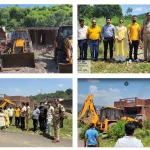It was a sunny forenoon of the mid-summer’s day of 1992 when our respected Urdu teacher, Master Peer Ghulam Ahmad of Naidkhai Sonawari (Bandipora) was teaching us an Urdu poem during the course of which he, in a nice tune, read this line of an anonymous poet: kamsin sahailiyun ka panghat pai jamghat ho raha hai; that is, little girls (friends) are assembling at the watering-place! This “panghat, watering-place or simply YARBAL in Kashmiri parlance” has been a common cultural avenue across cultures and it has played a great role in shaping the socio-cultural ethos of our yesteryears for almost every person of our localities, irrespective of her/his vocational affiliations would have to touch the YARBAL once, twice or a multiple times during the day.
From the primitive levels of human civilization YARBAL has had been a place where everything good or bad of the society would be discussed between friends and acquaintances whenever they have had the chance to meet. It doesn’t, however, mean that there used to be any formal efforts to build or shape the societal dimensions of a people. There simply used to be just informal meetings and associations of people driven by the basic necessity of life, that is, water. The water, we know, was taken to homes in pitchers for drinking; it was also taken in buckets for the cattle and also for other purposes.
There is a beautiful passage in the Qur’an about a watering-place associated with the Prophet Moses (‘AS). When Moses (‘AS) had to flee from Egypt he found a watering-place in Madyan where people were watering their flocks. However, two girls, one of whom was wedded by her father to Moses (‘AS) later on, were not strong enough to water their flocks. So, Moses (‘AS) found it his responsibility to help them water their flocks. In this context, there is a beautiful invocation (prayer) which Moses (‘AS) made after doing the service to the women. The Qur’an says: “So he watered (their flocks) for them; then he turned back to the shade, and said: “O my Lord! Truly I am in (desperate) need of any good that You do send me!” (al-Qasas: 24)
It is no wonder then that our forefathers would select such places for the YARBAL that would bring a sense of relief and peace to those who used to be attached to these watering places the most. We know the “over-burdened women folk” had to do most of the domestic work and fetching water from the YARBAL constituted the most part of it. No doubt these “poor beings” have had a chance to “prolong” some of their work at the YARBAL to have some “sigh of relief!”
The hustle and bustle at the YARBAL would begin at dawn and it continued till late evening. Naturally, the first beings to touch the YARBAL would be the mosque-goers (namazis) who would make ablutions with cool fresh water which initiated the sanctifying process of their body and soul which was culminated indeed first by the Adhan (call to the prayer) and then by the dawn prayer (Salah al-Fajr). Then the first rays of sunlight would awaken the womenfolk and they would queue towards the YARBAL to fetch water. With earthen pitchers on their heads they would also take the kitchen-ware (utensils) in a basket usually made of wicker work (bani-phout) and would thus start their work of cleaning these utensils with sand, clay or ash! This process would give women some leisure (sometimes they prolonged the task of 30 minutes up to more than an hour!) to discuss their domestic as well as general life experiences. It was here that the newly-wed women would be introduced to the new society through the more experienced ones. This social interaction would indeed relieve the stress of the women in general and that of the traumatized and agonized ones in particular.
The mothers-in-law, weighed down upon by their age as well as by the “unexpected behaviour” of their daughters-in-law, would shed tears while relating their experiences with other women. Same or more serious would be the case of the daughters-in-law who, while struggling to cope up with the new environment of their in-laws, would find some solace while giving vent to their “sufferings!” This state of affairs at the YARBAL would sometimes make it a place of “intrigue” which sometimes threatened the familial cohesion and social integration! It reminds us of the famous utterance of Lalla Daed which this famous mystic woman is reported to have uttered about her in-laws. The line goes like this: “hound maer tani kani kath; Lalli nilwath cxali ni zanh!” That is, whether they (her in-laws) slaughter a big lamb or a small one, Lalla would have to be content with the greenish stone lump (placed in her plate below some rice)!” The famous song of Habba Khatun also echoes a couplet about the YARBAL like this: “ghar-i drayaes aabi natis, nout mai phutno malineo ho; ya ditoum nati nouta nati natichai hari malineo!” That is, the last Queen of Kashmir pleas before her paternal abode as: “I left the home to fetch a pitcher of water, but (alas) the pitcher crashed! (Now) either send me a pitcher to replace the broken one, or send me the amount so that I can purchase a new one!”
This doesn’t, however, mean that the YARBAL was exclusively for women. Men too were attached with the YARBAL in their own way. Early in the morning they would water their flocks (sheep usually) at the YARBAL before directing them to the pastures. Cattle, especially cows would be watered at the YARBAL before being taken to the grazing fields or orchards. And, as the sole “luxurious” means of transport, the “tonga” (horse-cart) would stop besides the YARBAL where the “tonga-wala” (cart driver), with the whip in one hand and the bucket in another, would water his panting horse while turning his whistling into a melodious tune on the pattern of some Kashmiri song. The cultivators, carrying the yokes (ploughs) on one of the shoulders, too would water their pair of oxen at the YARBAL before taking them for the day’s labour to till their fields.
Such used to be our routine attachment with the YARBAL in the villages. The YARBALs of our towns, especially of the river Jhelum, besides serving all or most of the above-mentioned purposes, would be used as “ports” for inter-district transportation. Many of such YARBALs are not altogether extinct yet. In this regard, who can forget the historical importance of KHOJA YARBAL, Srinagar? Not to speak of the Srinagar city, even the main (old) market of the famous literary town of the Valley, Hajin (Sonawari, Bandipora) is still called the YARBAL!
However, all these YARBALs or simply our YARBAL has lost all the socio-cultural and historical sheen due to our insensitivity vis-à-vis our rich cultural ethos coupled by the environmental catastrophe the Valley is heading to. There is a dire need of the revivification of the YARBAL which could bring back the lost cultural glory of our villages and towns because not only do our sheep and cattle need fresh running water but our Lallas and Habbas are yearning to give vent to their mystic experiences through vakhs and the songs of love, separation and agony through watsuns at and around the YARBAL!
(The author is Assistant Professor Islamic Studies at GDC Kokernag. Email: [email protected])





